... newer stories
Freitag, 15. März 2019
Weather report for 2018
beekids, 11:28h
Here is the final weather report for 2018 (the estate of the Biotechnical School Maribor). You can see important monthly data and a total average for 2018. The report shows that the average temperature in 2018 was 11.34 °C or higher by 0.79 °C compared to the 30-year average. However, the year 2018 was not the warmest, it still belongs to 2000 and 2014, when the average temperature was 12 °C.
The highest temperature was 33.9 °C, which is far from the record temperature measured on the property, which was 40.6 °C (August 8th 2013). But the record mark (- 23 °C) approached the lowest temperature in 2018, which was - 20.2 °C.
In 2018 there were 27 days warmer than 30 °C, fortunately only five days were such that even the lowest daily temperature did not fall below 20 °C (tropical night).
In the year 2018, precipitation was only 784.6 mm, which is much less than the 30-year average (893 mm). The highest precipitation was recorded in 1962 (1304 mm) and the lowest in 2011 (604 mm).
In 2018 we only had one very rainy day when 78.6 mm of precipitation fell (4. 5. 2018). Especially in the first half of the year, we felt that the rain was falling steadily (93 days of precipitation), but it should be emphasized that 31 days were of such occurrence as less than 1 mm precipitation fell. So we can say that it is often only a rosé, which does not greatly benefit the plants or can even harm them if the temperature is high enough (the possibility of mold and rust).
You can find more detailed information in the attachment.
weather_report_maribor2018 (pdf, 150 KB)
Comparison of average monthly temperatures in 2018 with the long-term average of the period 1981-2010.

Comparison of precipitation in 2018 with a long-term average of the period 1981-2010.
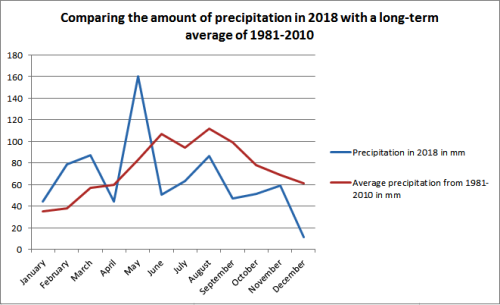
The highest temperature was 33.9 °C, which is far from the record temperature measured on the property, which was 40.6 °C (August 8th 2013). But the record mark (- 23 °C) approached the lowest temperature in 2018, which was - 20.2 °C.
In 2018 there were 27 days warmer than 30 °C, fortunately only five days were such that even the lowest daily temperature did not fall below 20 °C (tropical night).
In the year 2018, precipitation was only 784.6 mm, which is much less than the 30-year average (893 mm). The highest precipitation was recorded in 1962 (1304 mm) and the lowest in 2011 (604 mm).
In 2018 we only had one very rainy day when 78.6 mm of precipitation fell (4. 5. 2018). Especially in the first half of the year, we felt that the rain was falling steadily (93 days of precipitation), but it should be emphasized that 31 days were of such occurrence as less than 1 mm precipitation fell. So we can say that it is often only a rosé, which does not greatly benefit the plants or can even harm them if the temperature is high enough (the possibility of mold and rust).
You can find more detailed information in the attachment.
weather_report_maribor2018 (pdf, 150 KB)
Comparison of average monthly temperatures in 2018 with the long-term average of the period 1981-2010.

Comparison of precipitation in 2018 with a long-term average of the period 1981-2010.

... link (0 Kommentare) ... comment
Meteorological report for February (Maribor)
beekids, 10:35h
Are climate change really not happening? Weather conditions are changing rapidly, especially when compared to long-term measurements. This February was a real contradiction to last year's. February 2018 showed us that it is truly a winter month. This year, it's spring.
The difference between the highest (28th February) and the lowest (7th February) measured temperature in the month was as high as 31 °C. From this, we can understand, that we had cold nights and mornings and too high daily temperatures.
The average monthly temperature was much higher than the average of the period from 1981 to 2010, it was 4,7 °C, and it was 3 °C higher than the long-term average. By comparison, in February 2018, the average temperature was - 1.41 °C (6.11 °C lower). The long-term average for February is 1.7 °C in Maribor. If we compare only the average temperature of the second half of the month with the average period from 1981 to 2010, we can see that it was higher by 4.53 °C.
In February, the average temperature was only five times below the freezing point (0 °C). The maximum temperature did not reach even the freezing point. The minimum temperature was nine times above the freezing point. The lowest temperature in February was - 8 °C, and the highest temperature was 23 °C. Compared to February 2018, the lowest temperature was - 20.2 °C and the highest was 11.58 °C.

Precipitation data show that the trend of falling precipitation is still continuing. There was no snow fall at all, therefore drought is expected in March, especially in cereals (barley, wheat).
In February there was less precipitation than a long-term average. The measuring device detected only 16.2 mm of precipitation, and the long-term average is 38 mm precipitation. Most precipitation dropped in the first half of the month. In February 2018, dropped 78.6 mm of precipitation and 106.8 cm of snow.
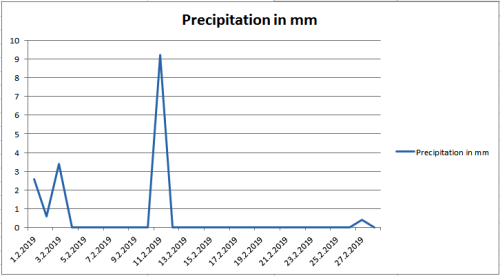
The average relative humidity in February was 67.85 %, which is even less than in January. In February 2018 it was as much as 86.42 %.
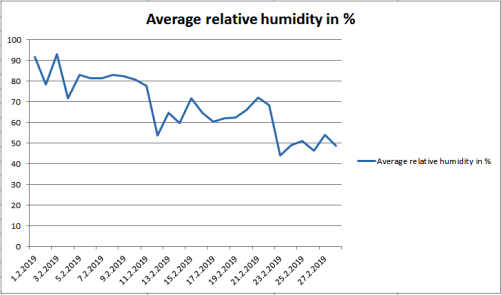
The difference between the highest (28th February) and the lowest (7th February) measured temperature in the month was as high as 31 °C. From this, we can understand, that we had cold nights and mornings and too high daily temperatures.
The average monthly temperature was much higher than the average of the period from 1981 to 2010, it was 4,7 °C, and it was 3 °C higher than the long-term average. By comparison, in February 2018, the average temperature was - 1.41 °C (6.11 °C lower). The long-term average for February is 1.7 °C in Maribor. If we compare only the average temperature of the second half of the month with the average period from 1981 to 2010, we can see that it was higher by 4.53 °C.
In February, the average temperature was only five times below the freezing point (0 °C). The maximum temperature did not reach even the freezing point. The minimum temperature was nine times above the freezing point. The lowest temperature in February was - 8 °C, and the highest temperature was 23 °C. Compared to February 2018, the lowest temperature was - 20.2 °C and the highest was 11.58 °C.

Precipitation data show that the trend of falling precipitation is still continuing. There was no snow fall at all, therefore drought is expected in March, especially in cereals (barley, wheat).
In February there was less precipitation than a long-term average. The measuring device detected only 16.2 mm of precipitation, and the long-term average is 38 mm precipitation. Most precipitation dropped in the first half of the month. In February 2018, dropped 78.6 mm of precipitation and 106.8 cm of snow.

The average relative humidity in February was 67.85 %, which is even less than in January. In February 2018 it was as much as 86.42 %.

... link (0 Kommentare) ... comment
Meteorological report for January (Maribor)
beekids, 09:27h
January is the central month of meteorological winter and is usually the coldest month of the year, which was not the case in January 2018, which was the third warmest January since the temperature has been measured in Slovenia. This year, January was more normal, although the temperatures were still too high.
The difference between the highest (January 17) and the lowest (January 26) measured temperature in the month was 23.3 °C.
The average monthly temperature was higher than the average of the period from 1981 to 2010, it was 0.17 °C and it was 0.27 °C higher than the long-term average. The long-term average for January is - 0.1 °C in Maribor. For comparison, in January 2018, the average temperature was 2.87 °C.
The difference in average temperature between the coldest (January 26) and the warmest (January 17) day was 12.38 °C.
In January, the average temperature was fourteen times below the long-term average (- 0.1 °C). The maximum temperature was three days above 10 °C, and only two days below 0 °C. The lowest temperature in January was - 9.6 °C and the highest temperature was 13.7 °C.
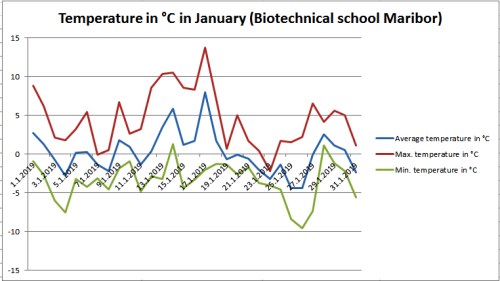
Precipitation data show that there was very little precipitation in January, which has been happening for more than half a year. The problem is that there were no snowfalls, which represent a stock of water for the spring months. There were seven rainy days, with 28.8 mm of precipitation, which is less as long as the long-term average (35 mm of precipitation). In January 2018, fell 44.4 mm of precipitation.

The average relative humidity in January was 77.22 %, which is less than in January 2018 (85.28%). Given the lower amount of precipitation this is normal. In January there was a significant fluctuation in air humidity, with only 55 % to 93 % of moisture.
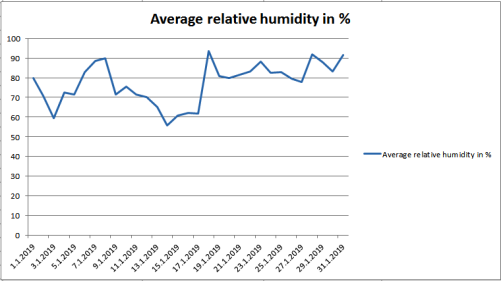
The difference between the highest (January 17) and the lowest (January 26) measured temperature in the month was 23.3 °C.
The average monthly temperature was higher than the average of the period from 1981 to 2010, it was 0.17 °C and it was 0.27 °C higher than the long-term average. The long-term average for January is - 0.1 °C in Maribor. For comparison, in January 2018, the average temperature was 2.87 °C.
The difference in average temperature between the coldest (January 26) and the warmest (January 17) day was 12.38 °C.
In January, the average temperature was fourteen times below the long-term average (- 0.1 °C). The maximum temperature was three days above 10 °C, and only two days below 0 °C. The lowest temperature in January was - 9.6 °C and the highest temperature was 13.7 °C.

Precipitation data show that there was very little precipitation in January, which has been happening for more than half a year. The problem is that there were no snowfalls, which represent a stock of water for the spring months. There were seven rainy days, with 28.8 mm of precipitation, which is less as long as the long-term average (35 mm of precipitation). In January 2018, fell 44.4 mm of precipitation.

The average relative humidity in January was 77.22 %, which is less than in January 2018 (85.28%). Given the lower amount of precipitation this is normal. In January there was a significant fluctuation in air humidity, with only 55 % to 93 % of moisture.

... link (0 Kommentare) ... comment
Preparation of Cloudy Apple Juice
beekids, 08:47h
The apples were sorted and washed in water,
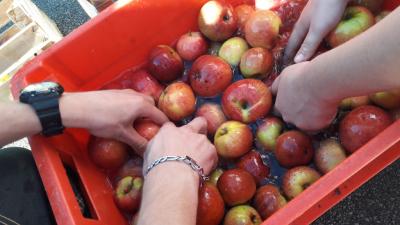
then we put them in a box and washed again.
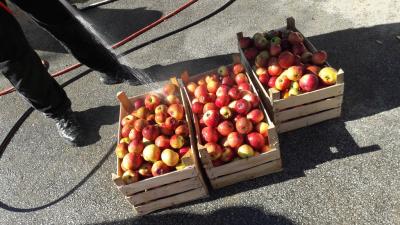
Then we crushed them in a mill
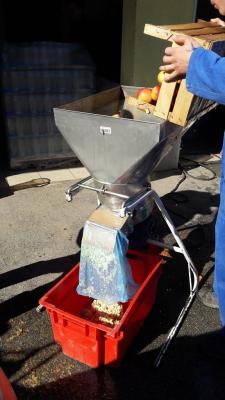
and mash transferred into the press.
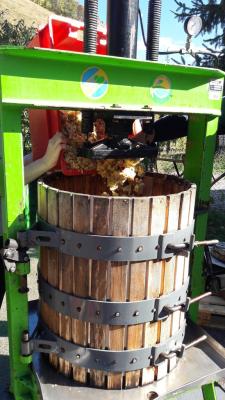

We squeezed the mash to 150 bars. The apples were overripe, so we squeezed out less juice than we expected.
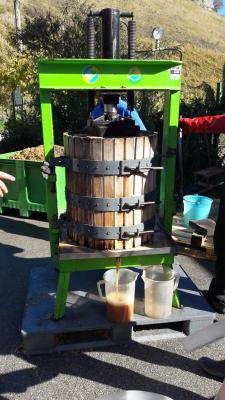
From 80 kg of apples we extracted 22 liters of apple juice. The juice was poured into a bowl through the strainer in which he waited until the next day.
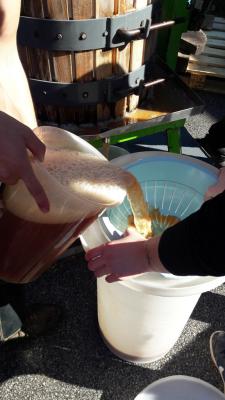
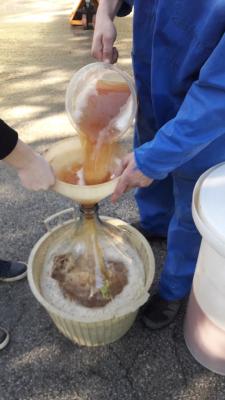
Overnight, the larger pieces of apples saturated. We did not add any additive to juice.
The next day, we pasteurized juice.
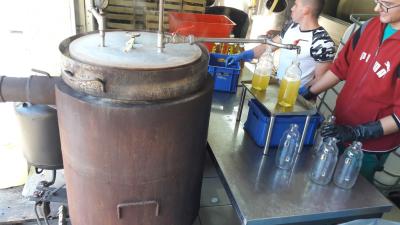

We prepared 14 liters of cloudy apple juice. The juice was pasteurized at 86 °C. When bottled it had a temperature of 78.8 °C, which dropped below 70 °C after 11 minutes. The bottles were closed with a stopper, and then laid for 1 minute to make the stopper disinfect. The bottles were cooled below 30 °C in cold water and dropped in wooden box.

then we put them in a box and washed again.

Then we crushed them in a mill

and mash transferred into the press.


We squeezed the mash to 150 bars. The apples were overripe, so we squeezed out less juice than we expected.

From 80 kg of apples we extracted 22 liters of apple juice. The juice was poured into a bowl through the strainer in which he waited until the next day.


Overnight, the larger pieces of apples saturated. We did not add any additive to juice.
The next day, we pasteurized juice.


We prepared 14 liters of cloudy apple juice. The juice was pasteurized at 86 °C. When bottled it had a temperature of 78.8 °C, which dropped below 70 °C after 11 minutes. The bottles were closed with a stopper, and then laid for 1 minute to make the stopper disinfect. The bottles were cooled below 30 °C in cold water and dropped in wooden box.
... link (0 Kommentare) ... comment
... older stories